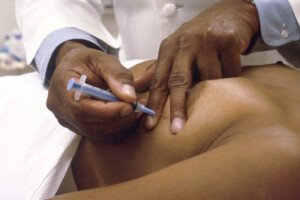
Have you found a breast lump but the mammogram is clear? Should you just let this go and put all your faith in the mammogram?
The expert sources for this article are Dr. Steven Standiford, MD, Chief of Staff Emeritus at the Cancer Treatment Centers of America Breast Cancer Institute across all five CTCA sites, and Dr. Debora Fineman, MD, a former diagnostic radiologist with Cancer Treatment Centers of America in Philadelphia.
Let’s first look at Dr. Fineman’s response:
“When patients present for imaging with a palpable mass, our protocol is to do both mammography and ultrasound,” says Dr. Fineman.
“If these do not resolve the issue, the patient is placed in the hands of the breast surgeon who evaluates the need for additional procedures such as fine needle aspiration, MRI or other evaluation.”
In other words, if a woman (or her doctor) discovers a lump in her breast, and the mammogram shows nothing, this should not be the end of the line. The situation still needs to be pursued!
Dr. Standiford explains, “The evaluation of a breast lump should include clinical breast exam, mammogram and ultrasound.
“If there is an index of suspicion, a fine needle aspiration biopsy or a core needle biopsy is the next approach.

A fine needle biopsy. Cancer.gov/Linda Bartlett
“An incisional or excisional biopsy should be only the last resort – if the results of all the studies fail to give a concordant result – one where the exam, imaging and pathology all point to the same diagnosis.
“I would NOT do an excision for a diagnosis regardless of whether the woman says she doesn’t care about scarring.
“However, an excision is an appropriate choice for some women who, after the evaluation has shown that the mass is benign, desires that the mass be removed to return her exam and imaging to normal.
“Of course, if a malignancy is encountered, we move off of this ‘pathway’ and follow typical guidelines for management of breast cancer, whether breast conservation or mastectomy.”
Breast cancer remains a significant health concern in the U.S., but its impact varies depending on several factors.
Breast cancer is one of the leading causes of cancer-related deaths among women.
According to the American Cancer Society, it is estimated that approximately 43,700 women will die from breast cancer in the U.S. in 2024.
Despite this, breast cancer survival rates have improved significantly over the past few decades, largely due to advances in early detection, treatment and awareness.
When this disease is detected early, the five year relative survival rate is around 99 percent.
 As a part of Dr. Standiford’s life-long commitment to improving cancer treatment, he has partaken in wide-ranging research and has been awarded grants to study breast and colon cancer.
As a part of Dr. Standiford’s life-long commitment to improving cancer treatment, he has partaken in wide-ranging research and has been awarded grants to study breast and colon cancer.
 Dr. Fineman has been in practice for over 30 years.
Dr. Fineman has been in practice for over 30 years.
 Lorra Garrick has been covering medical, fitness and cybersecurity topics for many years, having written thousands of articles for print magazines and websites, including as a ghostwriter. She is also a former ACE certified personal trainer.
Lorra Garrick has been covering medical, fitness and cybersecurity topics for many years, having written thousands of articles for print magazines and websites, including as a ghostwriter. She is also a former ACE certified personal trainer.
.









































